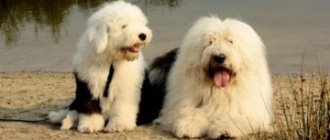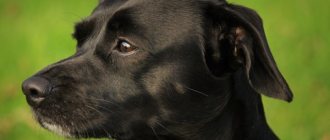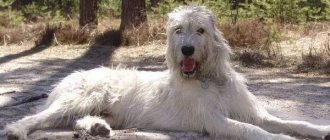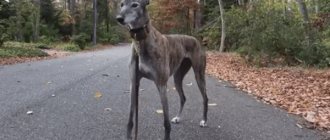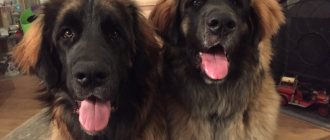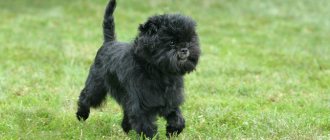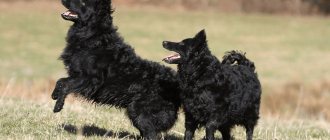Breed traits
Breed traits (on a 5-point scale)
| Bobtail (Old English Sheepdog) | |||
| Activity | in the house | 2.7 | |
| on the street | 4.3 | ||
| Obedience | training | 3 | |
| strangers | 4 | ||
| Domination | in family | 3.3 | |
| over dogs | 2.3 | ||
| Defending your territory | from people | 3 | |
| from dogs | 2.7 | ||
| Sociability | in family | 4.7 | |
| with strangers | 3 | ||
| with dogs | 3 | ||
| Concentration | in family | 1.3 | |
| in front of strangers | 2 | ||
| with dogs | 2.7 | ||
| Aggressiveness | in family | 2 | |
| to strangers | 2.3 | ||
| to the dogs | 2 | ||
| to cats | 1.7 | ||
| Family behavior | calmness | 3.3 | |
| demand for affection | 3.3 | ||
| excitability | 3.7 | ||
| playfulness | 4 | ||
| excessive barking | 2 | ||
| behavioral breakdowns | 1.7 | ||
| Tolerance for children | up to 4 years | 3 | |
| over 4 years old | 3.3 | ||
| Institutional use | watchman | 3.7 | |
| bodyguard | 3.7 | ||
This breed is often compared to the following dog breeds: Bearded Collie, Briard, Belgian Shepherd Tervuren, Rottweiler, German Shepherd.
The photo shows what a bobtail looks like:
General characteristics of the breed
A characteristic feature of this dog’s appearance is its short tail, reminiscent of a bob. Therefore, the name of the breed bob-tailed sheep-dog is translated from English as “shepherd with a tail like a bean.” This is a congenital feature, but some puppies are born with a long tail, in such cases it is docked. The Bobtail is also called the Old English Sheepdog, as it appeared in Great Britain in ancient times.
Bobtails are strong, hardy dogs. They are muscular, strong, and capable of hard work. They can carry heavy objects, perform various tricks, and perform in the circus. Bobtails have acting qualities; representatives of the breed have starred in several films.
Nowadays they are rarely used as shepherds; bobtail guards are also poor. Although they have an instinct to protect the territory, they also will not give offense to the owner, but they treat all people kindly, affably, and never show aggression. Thanks to their tolerance, attentiveness and people-oriented approach, they often work as guide dogs for the disabled and therapy dogs for children with developmental delays.
| Options | Characteristic |
| breed name | Bobtail, Old English Sheepdog |
| a country | Great Britain |
| group of breeds according to the ICF classification | herding and cattle dogs, shepherd section |
| application | shepherd, guide dog, therapy dog, sled dog, companion |
| appearance features | large stature, lush wavy coat, short stubby tail |
| life expectancy | 12-13 years old |
| height | males 56-63 cm, females 54-61 cm |
| weight | males 34-46 kg, females 32-44 kg |
| character traits | friendly, calm, devoted |
| activity | average |
| aggression | No |
| intelligence | smart, quick-witted |
| difficulty of care | complex coat care, although sheds infrequently, grooming and trimming are required |
pros
The Old English Sheepdog is popular because of its calm, friendly nature. But it has a few more advantages:
- balanced temperament;
- chic appearance;
- friendly, not aggressive;
- devoted, faithful, loves to spend time with the owner;
- hardy, efficient;
- smart, has a good memory, easily remembers commands;
- loves children, is patient with them, can be a nanny;
- gets along well with other pets
Minuses
This breed is large, active, and difficult to keep in a city apartment. It should not be owned by inactive owners, or by those who are away from home for a long time. Bobtails do not tolerate loneliness well. They have a few more disadvantages:
- They shed heavily and are not suitable for owners with allergies;
- slobbery, bring home a lot of dirt from the street;
- require long walks with physical activity;
- Grooming is difficult and maintenance is expensive;
- poor health.
The video will complement the characteristics of the breed:
Video: Old English Sheepdog (Bobtail). Breed characteristics, care
Video: Bobtail - interesting facts about the dog
Video: Bobtail is a breed of good-natured and absolutely non-aggressive dogs
History of the origin of the breed
Bobtails are one of the ancient dog breeds. Researchers note that their ancestors were brought to England from Ancient Rome. According to one version, the breed appeared as a result of crossing these dogs with Briard, South Russian Shepherd Dogs or Hungarian Cattle Dogs. This was done to consolidate working qualities and appearance features.
In those days, the strength, endurance, fearlessness, and obedience of dogs were valued. They independently grazed flocks of sheep and protected them from wild animals. They were independent and obtained food by hunting. Thick long hair protected them from bad weather. At that time, by law, English shepherds paid tax on dogs based on the length of their tail. Therefore, such a bob-tailed dog was popular.
Dog breeders became interested in the breed only at the end of the 19th century. In 1888, the first standard was adopted and the modern name appeared. This year marked the birth of the breed, although it has been known since ancient times. Thanks to their unusual appearance and balanced character, Old English Sheepdogs quickly gained popularity throughout the world. But in Russia, representatives of this breed appeared only in the 70s of the 20th century.
Possible diseases
Usually, with proper care and nutrition, a bobtail lives about 10-12 years. But even in these cases, the dog may develop health problems. Each breed is characterized by certain diseases to a greater or lesser extent. These include:
- Dilated stomach and volvulus.
- Cataract.
- Ataxia.
- Cerebellar abiotrophy.
- Congenital deafness.
- Dilated cardiomyopathy.
- Epilepsy.
- Autoimmune hemolytic anemia.
- Thrombocytopenia.
- Congenital dislocation of the elbow.
- Keratoacanthoma.
- Cancer in the nasopharynx.
- Progressive retinal atrophy.
- Hip dysplasia.
In addition, your dog may experience various allergic reactions to certain medications. After use, chills, ataxia, coma, or even death may occur.
Bobtails after grooming
But these diseases do not at all mean that every bobtail should exhibit one or more diseases. It all depends on the individual characteristics of the dog’s body.
Appearance Standards for Old English Sheepdogs
Bobtails are a large breed of dog. Males grow up to 63 cm, females are slightly smaller. They weigh on average 38-45 kg. They grow quickly, the puppy gains this weight by six months. These dogs have a strong build, which appears even more powerful due to their lush, long coat. Characteristic features of appearance are a large shaggy head, a short tail and gray and white color. Externally, the dog resembles a bear cub.
Head
The head is large, but proportional to the body. The shapes are angular, smoothed by fluffy wool, the shape is almost square. The forehead is convex, the brow ridges are well defined. The muzzle is elongated, but not long, and does not taper towards the nose. The stop is sharp, the bridge of the nose is wide and even.
The jaws are strong, the teeth are large and even. The lips are thick and black. They fit tightly, sometimes small jowls form in the corners, but they do not open the lower jaw. The nose is large, with wide nostrils, and colored black. Individuals with a blue color may be brown.
The eyes are medium-sized, oval, set wide apart. The eyelids are tight-fitting and black. The color of the iris is dark brown, blue eyes are possible. The look is attentive and cheerful. The eyes are not visible from under the long thick bangs. The ears are small, triangular with rounded tips. Set on the sides of the head, low. They hang down and are covered with thick hair
Frame
The Bobtail is a dog with a muscular, stocky, square build. The neck is set high, long and flexible, the withers are well defined. The chest is voluminous, the stomach is slightly tucked. The back is short and wide, the croup is raised above the line of the back, rounded.
The tail is set low and most dogs are short from birth. If it is long, it reaches the hock joint. It should be slightly curved, heavily covered with hair. Nowadays dogs with long tails are allowed for exhibitions, although previously they had to be docked.
Limbs
The forelimbs are set parallel, straight and muscular. Elbows are directed back, pressed to the body. The hind limbs are slightly longer than the forelimbs. The thighs are muscular, the hock joints are low and clearly visible. The feet are small, round, with short toes and hard pads.
The dogs move quickly and gallop. Despite their apparent clumsiness, they are agile and agile. But while walking, the body sways slightly, so the gait resembles that of a bear.
Coat and color
The coat is hard, long and lush. The dog looks shaggy, but if well combed or trimmed, it becomes attractive. Especially long hair on the head, back, and limbs. The guard hair is slightly wavy, the undercoat is dense and also long. This provides good water resistance and weather protection.
According to the breed standard, the color of bobtails is gray and white. White head, neck, forelimbs. It is advisable that these parts of the body do not have marks of a different color. The back, sides and croup are also monochromatic - painted in any shade of gray or blue. There may be white “socks” on the hind legs. There should be no red or brown spots.
Photos complement the description of the appearance:
Character and behavior of Old English Sheepdogs
Bobtails choose one owner, are devoted to him until the end of their lives, and have a hard time with separation. Although they are friendly and friendly with all family members, they listen to them and protect them. They love to be the center of attention, to be praised, they try to please their owner, and they participate in all activities. The owners note that bobtails are not able to get angry, offended or take revenge; they are not aggressive and peaceful.
This dog has a purely English balanced temperament. She will not impose herself, she senses that if a person is not interested in her, she will calmly lie down next to him. When no one is home, he gets very bored and can become depressed from prolonged loneliness. Therefore, someone who does not have time to train him should not get a bobtail.
The Old English Sheepdog is an excellent nanny. You can safely leave even small children with her - she will never offend you, or even growl. Will protect, protect, entertain. Bobtails are happy to play with older children, ride on a cart, and support any games. They are also friendly with other pets, protecting and herding everyone with whom they live in the same house. They never come into conflict with dogs.
The Bobtail is a very energetic, active and inquisitive dog. She never sits still. She needs to do something all the time, run somewhere. She is ready to participate in all family affairs and help. These are people-oriented dogs, they do not run away, as they try to constantly be close to family members, to “shepherd” them.
Features of training
Bobtails are obedient, intelligent dogs. They are easy to raise and train, even an inexperienced dog breeder can handle it. They have a good memory, they quickly remember commands, love to study, learn something new, and perform different tasks. The main thing is to immediately gain authority from the puppy. You need to show who is boss in the house, but you cannot hit the dog or shout at it. Then the adult dog will obey unquestioningly.
From the age of 2-3 months, you need to accustom your little bobtail to its name, place, and leash. At this age, he is able to learn basic commands:
- to me;
- sit;
- near;
- it is forbidden;
- stand;
- ugh;
- lie.
During training, you need to communicate with the dog in a calm, even voice. Physical punishment is not recommended; you can scold for mischief. The best way to train a bobtail is through praise and affection from the owner. Training should be regular and consistent.
While the puppy is small, you need to conduct them in the form of a game, keep them short. It is recommended to periodically reinforce the learned commands and skills. An adult dog will be happy to perform various tasks and tricks to please the owner.
It is not recommended to specifically train a bobtail for protection and guarding. He still won’t be able to rush at a person; he doesn’t have aggression in his character. But it can protect the owner, family members and property without difficulty. This dog has an imposing appearance and a loud, hoarse bark. Usually this already deters intruders.
Training and education
Bobtails are very intelligent and receptive to training, so usually there are no problems raising them. It is important to position yourself in such a way that the dog perceives you as its loving, kind owner; physical strength and aggression towards the bobtail are unacceptable.
You need to train your pet from the first minutes of its appearance in the house; it is also important to immediately begin teaching the dog simple commands and wearing a collar.
- Bobtails thrive in cold climates because their coat prevents the dog from getting cold.
- It is important to expose your pet to regular physical activity and constantly keep him busy with different games.
- Bobtails are wonderful companions and can accompany their owner while jogging or at sporting events.
- When a bobtail is happy, it obeys its owner unquestioningly.
- Such a dog is capable of aggression only if it is hurt and very frightened.
Keeping an Old English Sheepdog
The Bobtail is a large dog and will be uncomfortable in a small apartment. Due to the long hair, there can also be problems with apartment maintenance. This dog lives quietly on the street, its thick coat protects it from bad weather. It is better to keep a bobtail in a private house with a large plot.
Walking is mandatory, even when kept on the site. You need to walk 2 times a day for at least an hour. It is better to visit dog parks or go out of town, where the dog can run freely and frolic. You can walk without a leash - a bobtail will never run away, as it is very attached to its owner.
Hygiene procedures are the same as for other dogs. You need to keep your eyes and ears clean and clean them periodically. If the claws do not grind down on their own, they are trimmed with a nail clipper. To prevent tartar, you can give your dog chewing bones and cartilage.
Grooming
Caring for the bobtail's lush coat is difficult. The peculiarity is that they do not shed seasonally. The undercoat changes little by little all the time. And the guard hair sheds 3 times up to 2.5 years and becomes more and more rigid.
It is necessary to brush the dog 3-4 times a week; during shedding, this should be done every day. Show dogs also require professional grooming. Pets often get haircuts. A dog with a haircut is easier to care for and keep clean. Usually the hair on the paws, under the tail, on the belly and head is trimmed. In hot weather, you can cut your bobtail shorter.
If the dog is not cut, it is recommended to collect the hair on its head so that it does not fall in the eyes - it interferes with its vision. It is also necessary to trim the hair between the toes, then the dog will bring in less dirt from the street.
After each meal, the dog must be washed, otherwise the hair around the jaws will turn brown. After walks, wash paws and belly. In dirty weather, it is worth taking your dog outside in waterproof overalls.
It is often not recommended to completely bathe a bobtail; the fatty grease is washed off from the skin. Once every 1-2 months is enough. Be sure to use shampoo for long-haired dogs, conditioner, and antistatic agent. After bathing, it is better to dry the coat with a hairdryer to prevent the skin from burning and developing dermatitis.
From the video you can learn how to care for fur:
Video: Grooming techniques for the Old English Bobtail Sheepdog
Video: Bobtail - washing and drying
Video: Grooming an Old English Sheepdog (Bobtail)
Nutrition
The Old English Sheepdog is unpretentious in food. Veterinarians recommend feeding representatives of the breed with natural products. It’s just important to make the right diet. The dog should not be overfed to prevent it from gaining weight. But food must provide the body with all the necessary nutrients.
The diet of an adult dog should consist of the following products:
- lean meat - poultry, beef, rabbit;
- tripe and other offal;
- cartilage;
- sea fish without bones;
- dairy products;
- cereals;
- any vegetables except potatoes and legumes.
Protein foods should make up at least half of the diet. You should not give your dog smoked meats, fatty foods, confectionery, sweets, or baked goods. When feeding naturally, on the recommendation of a veterinarian, you need to add multivitamins to your food.
You can feed your bobtail with dry food. But you need to choose super-premium or holistic options with a high protein content. They should be designed for large breed dogs, preferably with additives for a beautiful coat. Such food is not cheap and you will need a lot of it depending on the weight of your pet.
Health
Bobtails live as long as other large dogs - on average 10-12 years. Even with proper care, they rarely live longer than 13 years. Their health is also not very good; congenital and acquired diseases are common:
- joint dysplasia;
- otitis;
- eye diseases, vision loss;
- dermatitis, eczema;
- bloating;
- epilepsy;
- diabetes;
- hypothyroidism;
- heart failure.
Bobtails are very sensitive to medications, so if they feel unwell, it is better to consult a veterinarian. It is recommended to undergo regular preventive examinations, get all necessary vaccinations on time, give anthelmintic drugs, and treat the fur for parasites.
Nutrition
A dog of any breed needs special nutrition. The bobtail was no exception. Although at first glance it may seem that the pet does not care what it eats. But that's not true. Each owner chooses how to feed the dog.
That is, it can be a special balanced food or regular human food. The main thing is to provide the bobtail with the necessary amount of vitamins and minerals that are needed for the proper functioning of internal organs and maintaining a normal appearance.
Mom bobtail with puppies on a walk
If the choice fell on normal and simple food, then there is an approximate menu for the dog, which should be given from a young age. It consists:
- Dairy products. It is best if among them there is kefir and fermented baked milk. These products are aimed at forming and maintaining healthy bones in all the body.
- Lean meats and cooked poultry. The dog's stomach will cope well with such food and there will be no problems in the future with diseases of the gastrointestinal tract.
- Tripe, liver, bones and other offal. They can be used as a feed or broth for your dog.
- Fish without bones. Can be given separately or combined with meat. But for a bobtail to eat enough fish, it will need 2 times more fish than meat. Can be given cooked or raw.
- Vegetables. A dog can be given almost all types of food, with the exception of legumes and peas, which cause intestinal upset. If beets and carrots are constantly present in the dog’s diet, this may affect the color of the pet’s coat.
- Cereals. Dogs should be on the menu every day. You can give completely different cereals in combination with lean meats, cooked poultry, raw fish, dairy products, vegetables or offal. Cereals are an important source of carbohydrates, without which the dog will not feel healthy.
Food developed by good manufacturers must be given to your pet. They contain correctly and balanced all the vitamins and minerals that are very important for a growing body. For an adult dog, specialized food can be given along with regular food.
How to buy an Old English Sheepdog puppy
A purebred puppy can only be purchased from a good nursery. Dogs are more expensive there, but there is no risk of buying a mixed breed or a sick dog. In Moscow, the cost of bobtails ranges from 40 to 80 thousand rubles. Prices may be lower on the market or from private breeders, but there is no guarantee that the dog is purebred.
Before purchasing, you need to study the living conditions of the animals, all documents, and veterinary certificates. It is recommended to get to know the mother, since many character traits are inherited. When choosing, you need to pay attention to cheerful, not cowardly, curious kids. A healthy puppy should be well-fed and active. He has shiny fur, a wet nose, clean eyes and ears.
The photo shows what the puppies look like:
The video complements the description of the breed:
Video: Bobtail.
Video: Bobtail or Old English Sheepdog. Pros and cons, price, how to choose, facts, care, history
Video: Bobtail - a dog with a short tail: description of the Old English Sheepdog
The Bobtail is a kind and intelligent family dog. She is calm and obedient, loves children and is easy to train. Not aggressive at all, but will become a good defender. Despite their funny appearance and seemingly clumsy gait, these dogs are distinguished by great strength, endurance, and agility. They can perform in the circus and act in films. And if you give your bobtail enough attention, it will become a faithful and loving companion.
Interesting facts about bobtails
- The Bobtail is a breed of dog that is often found in the role of a guide dog.
- Dogs of this breed are real favorites of Hollywood directors; bobtails often become heroes of numerous films and cartoons.
- The Bobtail was Sir Paul McCartney's favorite breed.
- These dogs have a unique voice that is unlike any other dog.
- Bobtails are divided only by coat color; there are no divisions within the breed.
If you study the reviews about the bobtail, you can make sure that this is an extremely kind, friendly and intelligent dog, which is rightfully considered one of the best family breeds.
They are funny, active and boundlessly devoted to their owner, being his faithful friend and companion for many years.
